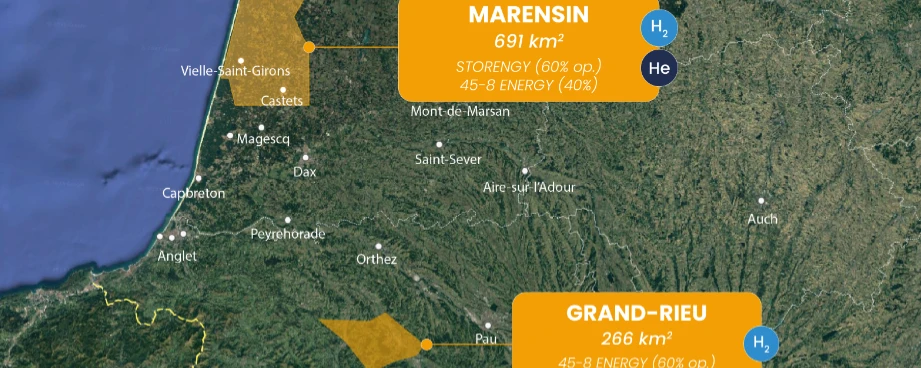

“Nouvelle-Aquitaine” Region : the birth of natural hydrogen exploration in France ?

As pioneer, 45-8 ENERGY is a company dedicated to the exploration and production of eco-responsible and strategic industrial gases: helium and natural hydrogen, as well as the resources that can be associated with.
Hydrogen has a very low carbon footprint because its production is totally natural via geological processes in the subsurface. It does not require the use of critical and/or natural resources (as pure water), it is very competitive economically due to its low operating cost. Three times more energetic than oil, and whose combustion produces nothing but energy and pure water, hydrogen is now seen as a substitute for fossil fuels and as an energy carrier to provide a complementary solution to the current low-carbon hydrogen mix and to the intermittent nature of renewable energies.
Committed to energy and ecological transition, 45-8 ENERGY aims to produce these resources as close as possible to the European consumers.
Being convinced that “Nouvelle-Aquitaine” region is a favorable area for the natural hydrogen generation in subsurface, 45-8 GRAND RIEU (affiliate of 45-8 ENERGY associated with two minor shareholder M&U and Lavoisier H2 Geoconsult) decided to partner with Storengy (affiliate of Engie) to apply for two exploration licenses in 2023.
The 2 licenses, applied for a 5-year duration, have roughly similar objectives:
Specify the extension of rocks that are likely to generate hydrogen and predict the potential migration paths;
Identify the formations that could be acting as reservoir or seal and favor natural hydrogen trapping in favorable structures ; large amount of patrimonial data will be used followed by new generation geophysical and geological acquisitions;
Quantify the volumes of hydrogen that could be accumulated, and assess the technical and economic feasibility to produce it;
Decide based on results if drilling an exploration well is worth;
Upfront of these applications, Nouvelle-Aquitaine is hosting since 2021 the H2NA multidisciplinary research project, labeled by pôle AVENIA (subsurface competitivity cluster) and led by 45-8 ENERGY, CVA Group, BRGM, UPPA, ENGIE ans Storengy. Its main objective is to evaluate in a homogeneous way the natural hydrogen exploration potential at the scale of the entire (administrative) region to encourage the application of exploration licenses in the area and progressively select hotspots where to focus research and data acquisitions. This ambition has already been achieved with the application of 3 licenses.
Furthermore, the integration of natural hydrogen in the list of resources in the French Mining Code in April 2022, played a critical role to convince companies to select France for conducting exploration for such an emerging resource.
Briefly, why the “Nouvelle-Aquitaine” region?
At present, the most efficient mechanism to generate natural hydrogen is serpentinization. This is a geological process in which predominantly ultrabasic rocks are oxidized by water to form serpentine group minerals by producing hydrogen and enhancing the pH of the fluids which become hyperalkaline due to the formation of OH- ions during the reaction (SUZUKI et al., 2015; VACQUAND et al., 2018; ZGONNIK, 2020).
An ideal candidate for serpentinization is the presence of an uplifted mantle wedge at relatively "shallow" depth (8-10 km) in the Western part of French Pyrenees. Such body is inferred by i) a positive magnetic anomaly (>60 nT), interpreted as resulting from magnetite production during serpentinization of mantle rocks (MALVOISIN et al., 2012; OUFI et al., 2002), ii) a strong Bouguer gravity anomaly (>20 mGal) (PEDREIRA et al., 2007; PEDRERA et al., 2017; VACHER et SOURIAU, 2001), and iii) high seismic velocities (Vp121≈ 7.3 km s−1, Vs ≈ 4.2 km s−1). Temperature and pressure conditions (>200 °C) are favorable for serpentinization and H2 generation (MCCOLLOM AND BACH, 2009).
The Arbailles Massif karst system to the SW is an ideal entry point for meteoric waters that can easily reach the Mantle wedge through the deep Pyreneans faults.
Moreover, generated H2 might migrate vertically towards geological structures prone for trapping in the subsurface or laterally along the main fault of the region, the North Pyrenean Fault (NPF). This could particularly explain the H2, Rn and CO2 concentration anomalies in soil gas highlighted in the Mauléon Basin (LEFEUVRE et al. 2021) which seem to correlate with major faults of the north Pyrenean area.
The Aquitaine basin was massively covered by subsurface analyses and seismic campaigns since the 50's especially north of the NPF where multiple oil and gas discoveries were made (including the giant Lacq field). South of the NPF, the area was almost not explored. Indeed, even though reservoirs, seals and structural closures are partly extending, hydrocarbon source rock maturity was found to be overmature making prospectivity for oil and gas poorly attractive.
This area is therefore a high hydrogen potential area with already identified structural traps, ideal location to deploy as well 45-8 ENERGY inhouse geochemical tool SurfMogH2, a H2 monitoring probe able to measure hydrogen seeps over months at 1m in the ground.
As mentioned before, hydrogen has become a key pillar in the objectives of ecological transition and global decarbonization. Thanks to its storage/unstorage capacities, it would enable the massive development of virtuous sectors, as well as the decarbonization of heavy mobility in the “Nouvelle-Aquitaine” region and the local petrochemical industry (Lacq basin), both of which consume large quantities of hydrogen. Many projects of production and consumption of low carbon hydrogen are expected in the “Nouvelle-Aquitaine” region and the coordination between the various players is already underway at regional and trans-Pyrenean level
.
Map of the 45-8 ENERGY exploration licenses in “Nouvelle Aquitaine” region (France)
Author : Louise LENOIR, Geoscientist chez 45-8 ENERGY
Register before Sept. 30 and save 10%. Places are limited for the face-to-face component.